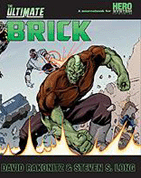
|
About OgreCave and its staff
|

|
by Justin Mohareb
Imagine the crunchiest splat-book you’ve ever seen. Imagine page upon page of neat tricks and special abilities, all based around super-strength and its related abilities. That’s pretty much The Ultimate Brick in a nutshell. (No, this is The Ultimate Brick in nutshell: “Man, that was a weak nut! Or maybe I’m just so very strong!” Because The Ultimate Brick is about Bricks, who are all super-strong characters. So it would be able to break out of the... ah, forget it.) Like its predecessors in the Ultimate series, The Ultimate Brick presents every piece of information you’d need about Brick characters, including dozens of Brick Tricks, guidelines for building and playing Bricks, new rules for the studied application of Strength, and a few sample Bricks.
Laying the foundation There are enough powers to simulate most of the super-strongmen of the source material (comic books). There are tricks to simulate a character that gets stronger as he gets angrier, who can roll people up in concrete, inhale a room full of toxic gas, or transform into (or just have) a super-tough body made of metal or stone. The section on building a brick starts out with an expansion and discussion of the Strength attribute and optional rules for using it. These include new tables for throwing and jumping, and optional rules on negative strength. Next come suggestions for using the other attributes for your brick, what skills a brick should have, appropriate perks and talents, and a rundown of which powers would be appropriate for a brick, as well as good power modifiers to apply to them. These suggestions are put into practice in the Brick Tricks section, showing how various powers and modifiers can be used to represent the various effects of super-strength in Champions. There are brick origins, personalities and archetypes to help during character construction, as well as suggestions for building bricks in various genres, though the book’s strength (sorry) does lie primarily in the superhero genre. After the “creating your brick” section, we get a “brick campaigning” chapter. As in previous sections, it’s a comprehensive look at how you can bash a super strong character up against the Hero rules in such a way as to gain maximum advantage. In the Combat Maneuvers section, particular attention is given to Grabs and Haymakers, two attack maneuvers that are particularly attractive to someone with a strength characteristic of around 60. We also get two full pages on the Fastball special and how to model it in Champions. The Fastball Special, for the three people in the audience who are unfamiliar with it, is when a brick grabs a smaller team-mate and hurls them, bodily, at the opposition. This adds extra oomph and distance to a charge attack. The classic example is Wolverine and Colossus of the X-Men. Campaigning also covers how the Brick can affect his environment. It is primarily concerned with breaking things, and has a section on lower and higher gravity, as well as a sidebar for pushing planets out of their orbits. The book concludes with a selection of Bricks for Champions and other genres, and all the tables in the book gathered into one place. The reprinting of the tables strikes me as an unnecessary use of eleven pages; that’s a significant chunk of page count, which could have been used for other things. Palladium products, while problematic in other ways, provide Tables of Contents that are shockingly complete. Hero Games should learn from their example, and could have let The Ultimate Brick's charts be referenced off the main ToC. Artwise, the book is fairly good. Illustrations tend to be directly relevant to the topics on their pages and competently done. The cover illustration is somewhat weak, with bad detail on Defender and Ironclad (although Ironclad never looks good; he’s no Obsidian). The book’s margins are once again a bit large, and there aren’t enough sidebars or art spill-over to make up for them.
Conclusions
|
||
 The Ultimate Brick
The Ultimate Brick